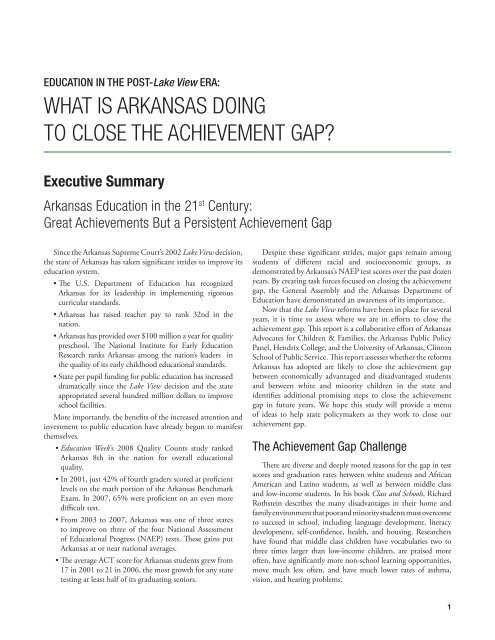WHAT IS ARKANSAS DOING TO CLOSE THE ACHIEVEMENT GAP?
WHAT IS ARKANSAS DOING TO CLOSE THE ACHIEVEMENT GAP?
WHAT IS ARKANSAS DOING TO CLOSE THE ACHIEVEMENT GAP?
Create successful ePaper yourself
Turn your PDF publications into a flip-book with our unique Google optimized e-Paper software.
EDUCATION IN <strong>THE</strong> POST-Lake View ERA:<br />
<strong>WHAT</strong> <strong>IS</strong> <strong>ARKANSAS</strong> <strong>DOING</strong><br />
<strong>TO</strong> <strong>CLOSE</strong> <strong>THE</strong> <strong>ACHIEVEMENT</strong> <strong>GAP</strong><br />
Executive Summary<br />
Arkansas Education in the 21 st Century:<br />
Great Achievements But a Persistent Achievement Gap<br />
Since the Arkansas Supreme Court’s 2002 Lake View decision,<br />
the state of Arkansas has taken significant strides to improve its<br />
education system.<br />
• The U.S. Department of Education has recognized<br />
Arkansas for its leadership in implementing rigorous<br />
curricular standards.<br />
• Arkansas has raised teacher pay to rank 32nd in the<br />
nation.<br />
• Arkansas has provided over $100 million a year for quality<br />
preschool. The National Institute for Early Education<br />
Research ranks Arkansas among the nation’s leaders in<br />
the quality of its early childhood educational standards.<br />
• State per pupil funding for public education has increased<br />
dramatically since the Lake View decision and the state<br />
appropriated several hundred million dollars to improve<br />
school facilities.<br />
More importantly, the benefits of the increased attention and<br />
investment to public education have already begun to manifest<br />
themselves.<br />
• Education Week’s 2008 Quality Counts study ranked<br />
Arkansas 8th in the nation for overall educational<br />
quality.<br />
• In 2001, just 42% of fourth graders scored at proficient<br />
levels on the math portion of the Arkansas Benchmark<br />
Exam. In 2007, 65% were proficient on an even more<br />
difficult test.<br />
• From 2003 to 2007, Arkansas was one of three states<br />
to improve on three of the four National Assessment<br />
of Educational Progress (NAEP) tests. These gains put<br />
Arkansas at or near national averages.<br />
• The average ACT score for Arkansas students grew from<br />
17 in 2001 to 21 in 2006, the most growth for any state<br />
testing at least half of its graduating seniors.<br />
Despite these significant strides, major gaps remain among<br />
students of different racial and socioeconomic groups, as<br />
demonstrated by Arkansas’s NAEP test scores over the past dozen<br />
years. By creating task forces focused on closing the achievement<br />
gap, the General Assembly and the Arkansas Department of<br />
Education have demonstrated an awareness of its importance.<br />
Now that the Lake View reforms have been in place for several<br />
years, it is time to assess where we are in efforts to close the<br />
achievement gap. This report is a collaborative effort of Arkansas<br />
Advocates for Children & Families, the Arkansas Public Policy<br />
Panel, Hendrix College, and the University of Arkansas, Clinton<br />
School of Public Service. This report assesses whether the reforms<br />
Arkansas has adopted are likely to close the achievement gap<br />
between economically advantaged and disadvantaged students<br />
and between white and minority children in the state and<br />
identifies additional promising steps to close the achievement<br />
gap in future years. We hope this study will provide a menu<br />
of ideas to help state policymakers as they work to close our<br />
achievement gap.<br />
The Achievement Gap Challenge<br />
There are diverse and deeply rooted reasons for the gap in test<br />
scores and graduation rates between white students and African<br />
American and Latino students, as well as between middle class<br />
and low-income students. In his book Class and Schools, Richard<br />
Rothstein describes the many disadvantages in their home and<br />
family environment that poor and minority students must overcome<br />
to succeed in school, including language development, literacy<br />
development, self-confidence, health, and housing. Researchers<br />
have found that middle class children have vocabularies two to<br />
three times larger than low-income children, are praised more<br />
often, have significantly more non-school learning opportunities,<br />
move much less often, and have much lower rates of asthma,<br />
vision, and hearing problems.<br />
1






